2020 HYUNDAI SONATA HYBRID cooling
[x] Cancel search: coolingPage 6 of 527

Introduction........................................................................\
................................1-2
Hyundai Motor America
........................................................................\
............1-2
Guide to Hyundai Genuine Parts
......................................................................1-3
How to Use This Manual
........................................................................\
............1-4
Safety Messages
........................................................................\
........................1-4
Fuel Requirements
........................................................................\
.....................1-5
Vehicle Modifications
........................................................................\
................1 -7
Vehicle Break-In Process
........................................................................\
...........1 -7
Vehicle Data Collection and Event Data Recorders
........................................1-8
California Perchlorate Notice
........................................................................\
....1-9
Consumer Information
........................................................................\
............1-10
Reporting Safety Defects
........................................................................\
.........1-11
HEV (Hybrid Electric Vehicle) System
.............................................................1-12
Driving the Hybrid Vehicle
........................................................................\
.......1-13Starting the Vehicle ........................................................................\
.............................1-13
Special Features ........................................................................\
..................................1-13
Hybrid System Gauge
........................................................................\
.........................1-15
Warning and Indicator Lights ........................................................................\
.............1-16
LCD Display Messages ........................................................................\
........................1-17
Energy Flow ........................................................................\
........................................1-20
Safety Precautions for Hybrid System ............................................................1-23Hybrid Vehicle Components ........................................................................\
..............1-23
Service Interlock Connector ........................................................................\
...............1-25
Hybrid Battery Cooling Duct ........................................................................\
..............1-25
If an Accident Occurs ........................................................................\
.........................1-26
When the Hybrid Vehicle Shuts Off ........................................................................\
...1-27
Foreword
1. Foreword / Hybrid System
Overview
1
Page 30 of 527
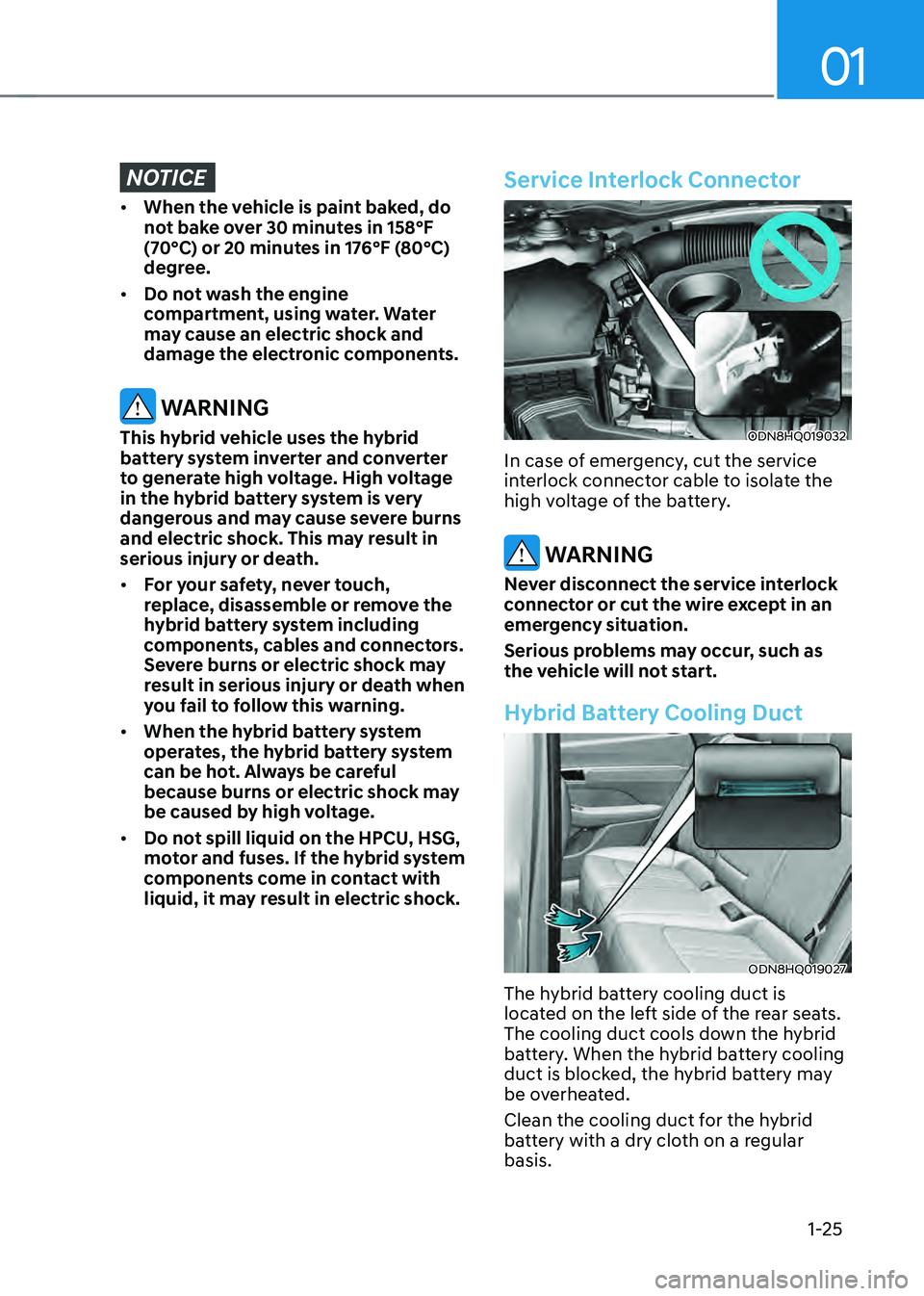
01
1-25
NOTICE
• When the vehicle is paint baked, do
not bake over 30 minutes in 158°F
(70°C) or 20 minutes in 176°F (80°C)
degree.
• Do not wash the engine
compartment, using water. Water
may cause an electric shock and
damage the electronic components.
WARNING
This hybrid vehicle uses the hybrid
battery system inverter and converter
to generate high voltage. High voltage
in the hybrid battery system is very
dangerous and may cause severe burns
and electric shock. This may result in
serious injury or death.
• For your safety, never touch,
replace, disassemble or remove the
hybrid battery system including
components, cables and connectors.
Severe burns or electric shock may
result in serious injury or death when
you fail to follow this warning.
• When the hybrid battery system
operates, the hybrid battery system
can be hot. Always be careful
because burns or electric shock may
be caused by high voltage.
• Do not spill liquid on the HPCU, HSG,
motor and fuses. If the hybrid system
components come in contact with
liquid, it may result in electric shock.
Service Interlock Connector
ODN8HQ019032
In case of emergency, cut the service
interlock connector cable to isolate the
high voltage of the battery.
WARNING
Never disconnect the service interlock
connector or cut the wire except in an
emergency situation.
Serious problems may occur, such as
the vehicle will not start.
Hybrid Battery Cooling Duct
ODN8HQ019027
The hybrid battery cooling duct is
located on the left side of the rear seats.
The cooling duct cools down the hybrid
battery. When the hybrid battery cooling
duct is blocked, the hybrid battery may
be overheated.
Clean the cooling duct for the hybrid
battery with a dry cloth on a regular
basis.
Page 31 of 527
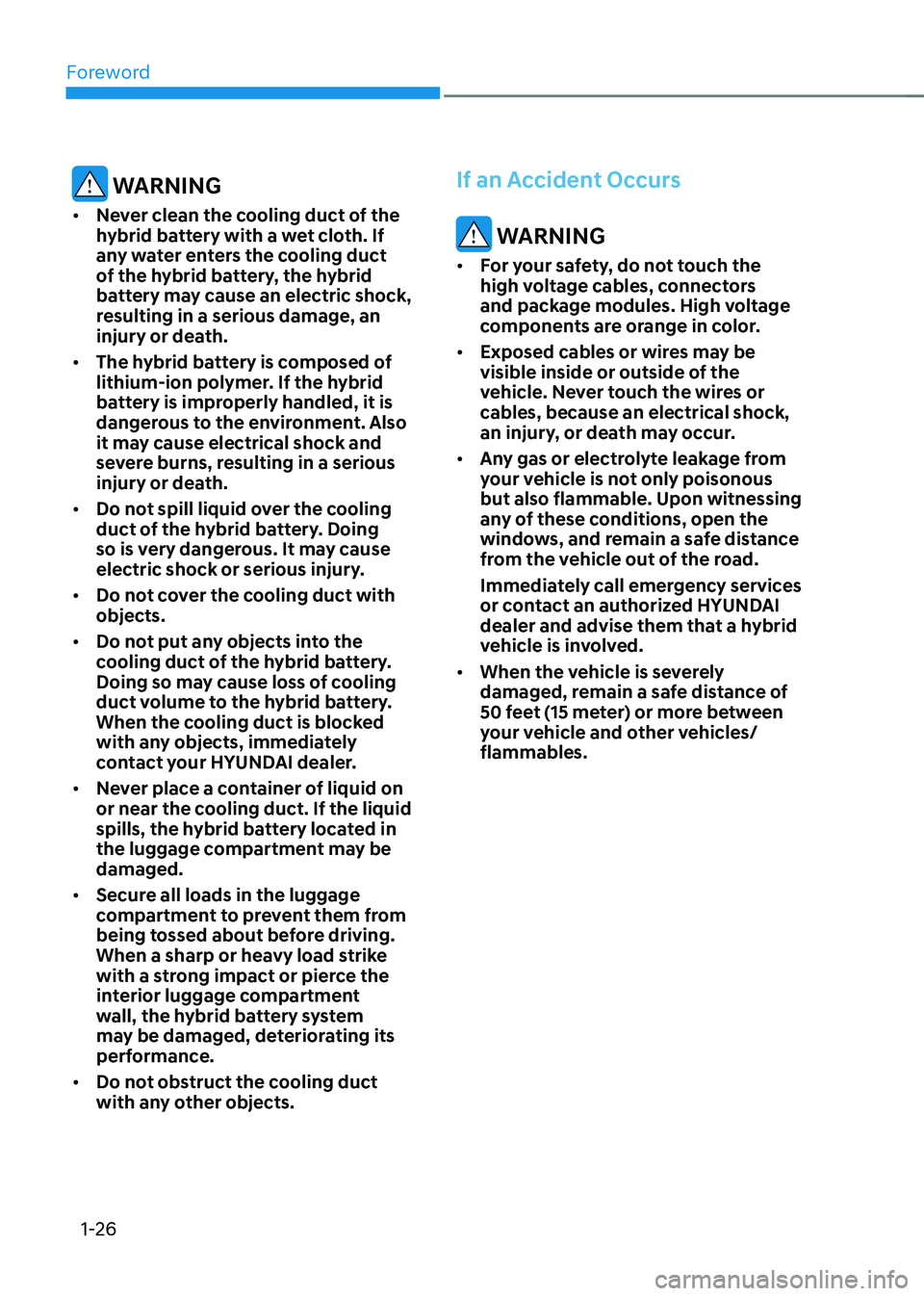
Foreword
1-26
WARNING
• Never clean the cooling duct of the
hybrid battery with a wet cloth. If
any water enters the cooling duct
of the hybrid battery, the hybrid
battery may cause an electric shock,
resulting in a serious damage, an
injury or death.
• The hybrid battery is composed of
lithium-ion polymer. If the hybrid
battery is improperly handled, it is
dangerous to the environment. Also
it may cause electrical shock and
severe burns, resulting in a serious
injury or death.
• Do not spill liquid over the cooling
duct of the hybrid battery. Doing
so is very dangerous. It may cause
electric shock or serious injury.
• Do not cover the cooling duct with
objects.
• Do not put any objects into the
cooling duct of the hybrid battery.
Doing so may cause loss of cooling
duct volume to the hybrid battery.
When the cooling duct is blocked
with any objects, immediately
contact your HYUNDAI dealer.
• Never place a container of liquid on
or near the cooling duct. If the liquid
spills, the hybrid battery located in
the luggage compartment may be
damaged.
• Secure all loads in the luggage
compartment to prevent them from
being tossed about before driving.
When a sharp or heavy load strike
with a strong impact or pierce the
interior luggage compartment
wall, the hybrid battery system
may be damaged, deteriorating its
performance.
• Do not obstruct the cooling duct
with any other objects.
If an Accident Occurs
WARNING
• For your safety, do not touch the
high voltage cables, connectors
and package modules. High voltage
components are orange in color.
• Exposed cables or wires may be
visible inside or outside of the
vehicle. Never touch the wires or
cables, because an electrical shock,
an injury, or death may occur.
• Any gas or electrolyte leakage from
your vehicle is not only poisonous
but also flammable. Upon witnessing
any of these conditions, open the
windows, and remain a safe distance
from the vehicle out of the road.
Immediately call emergency services
or contact an authorized HYUNDAI
dealer and advise them that a hybrid
vehicle is involved.
• When the vehicle is severely
damaged, remain a safe distance of
50 feet (15 meter) or more between
your vehicle and other vehicles/
flammables.
Page 207 of 527
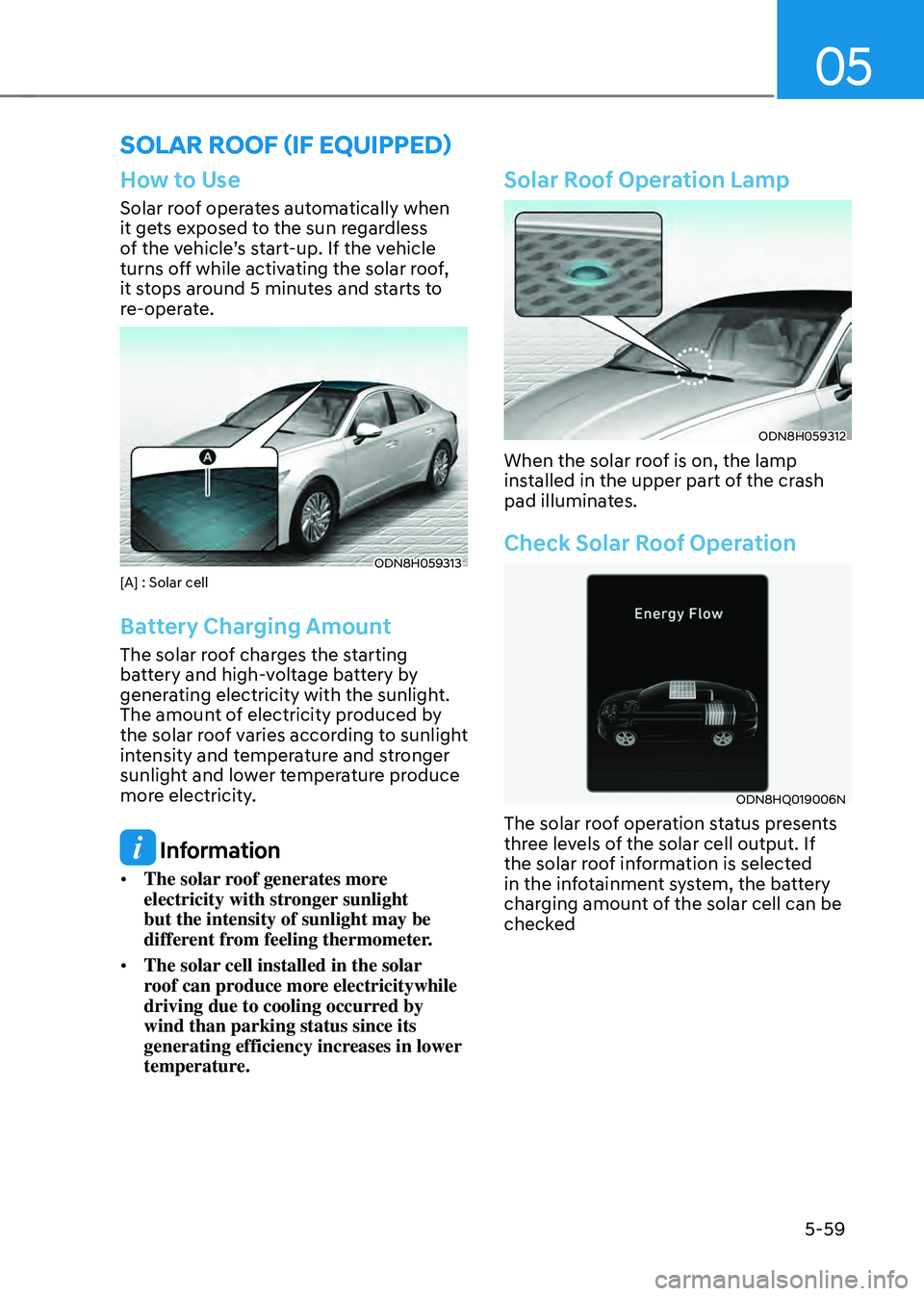
05
5-59
How to Use
Solar roof operates automatically when
it gets exposed to the sun regardless
of the vehicle’s start-up. If the vehicle
turns off while activating the solar roof,
it stops around 5 minutes and starts to
re-operate.
ODN8H059313[A] : Solar cell
Battery Charging Amount
The solar roof charges the starting
battery and high-voltage battery by
generating electricity with the sunlight.
The amount of electricity produced by
the solar roof varies according to sunlight
intensity and temperature and stronger
sunlight and lower temperature produce
more electricity.
Information
• The solar roof generates more
electricity with stronger sunlight
but the intensity of sunlight may be
different from feeling thermometer.
• The solar cell installed in the solar
roof can produce more electricitywhile
driving due to cooling occurred by
wind than parking status since its
generating efficiency increases in lower
temperature.
Solar Roof Operation Lamp
ODN8H059312
When the solar roof is on, the lamp
installed in the upper part of the crash
pad illuminates.
Check Solar Roof Operation
ODN8HQ019006N
The solar roof operation status presents
three levels of the solar cell output. If
the solar roof information is selected
in the infotainment system, the battery
charging amount of the solar cell can be
checked
SOLAR ROOF (IF EQUIPPED)
Page 251 of 527
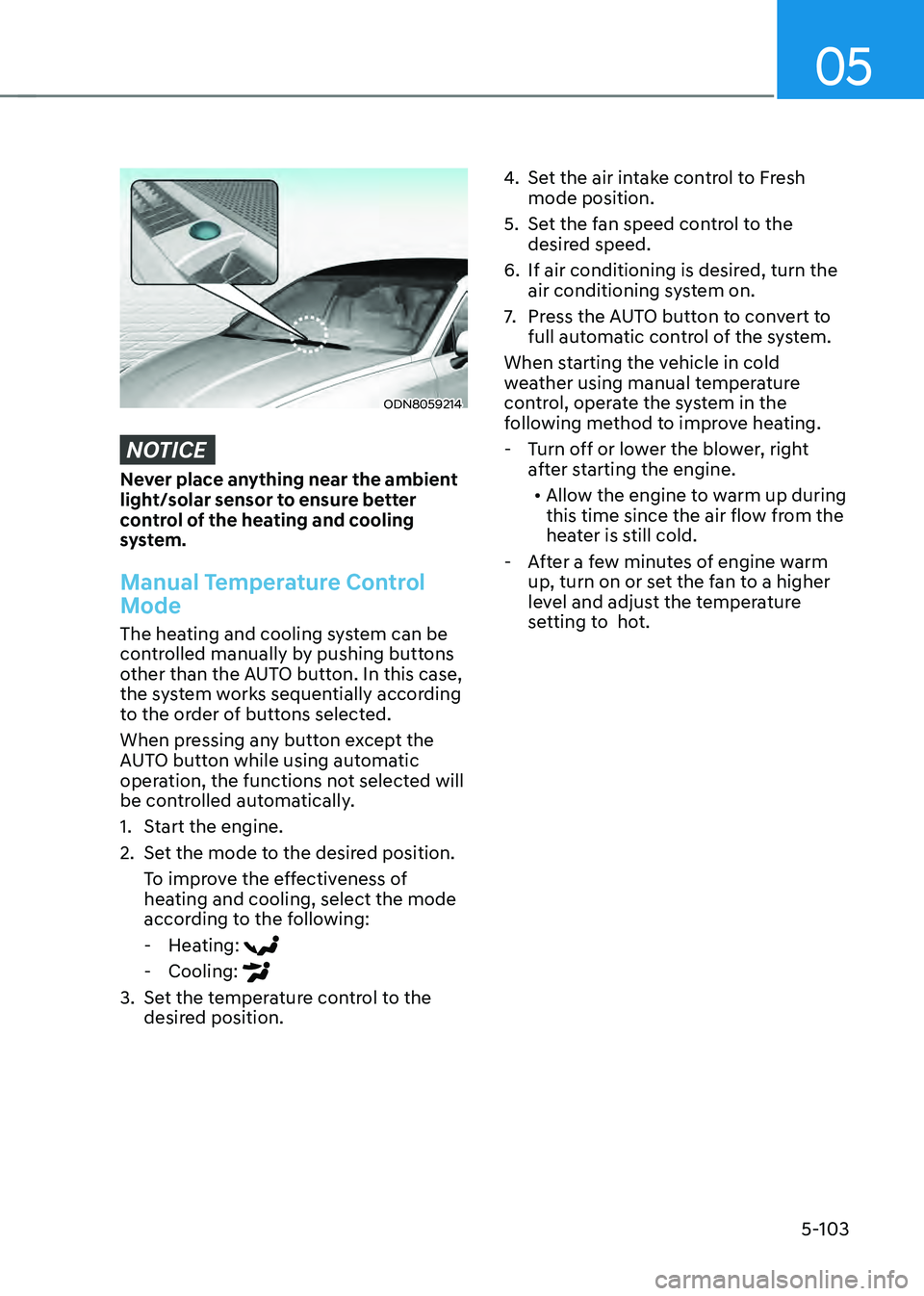
05
5-103
ODN8059214
NOTICE
Never place anything near the ambient
light/solar sensor to ensure better
control of the heating and cooling
system.
Manual Temperature Control
Mode
The heating and cooling system can be
controlled manually by pushing buttons
other than the AUTO button. In this case,
the system works sequentially according
to the order of buttons selected.
When pressing any button except the
AUTO button while using automatic
operation, the functions not selected will
be controlled automatically.
1. Start the engine.
2. Set the mode to the desired position.
To improve the effectiveness of
heating and cooling, select the mode
according to the following:
-Heating:
-Cooling:
3. Set the temperature control to the
desired position.
4. Set the air intake control to Fresh
mode position.
5. Set the fan speed control to the
desired speed.
6. If air conditioning is desired, turn the
air conditioning system on.
7. Press the AUTO button to convert to
full automatic control of the system.
When starting the vehicle in cold
weather using manual temperature
control, operate the system in the
following method to improve heating.
- Turn off or lower the blower, right
after starting the engine.
• Allow the engine to warm up during
this time since the air flow from the
heater is still cold.
- After a few minutes of engine warm
up, turn on or set the fan to a higher
level and adjust the temperature
setting to hot.
Page 258 of 527
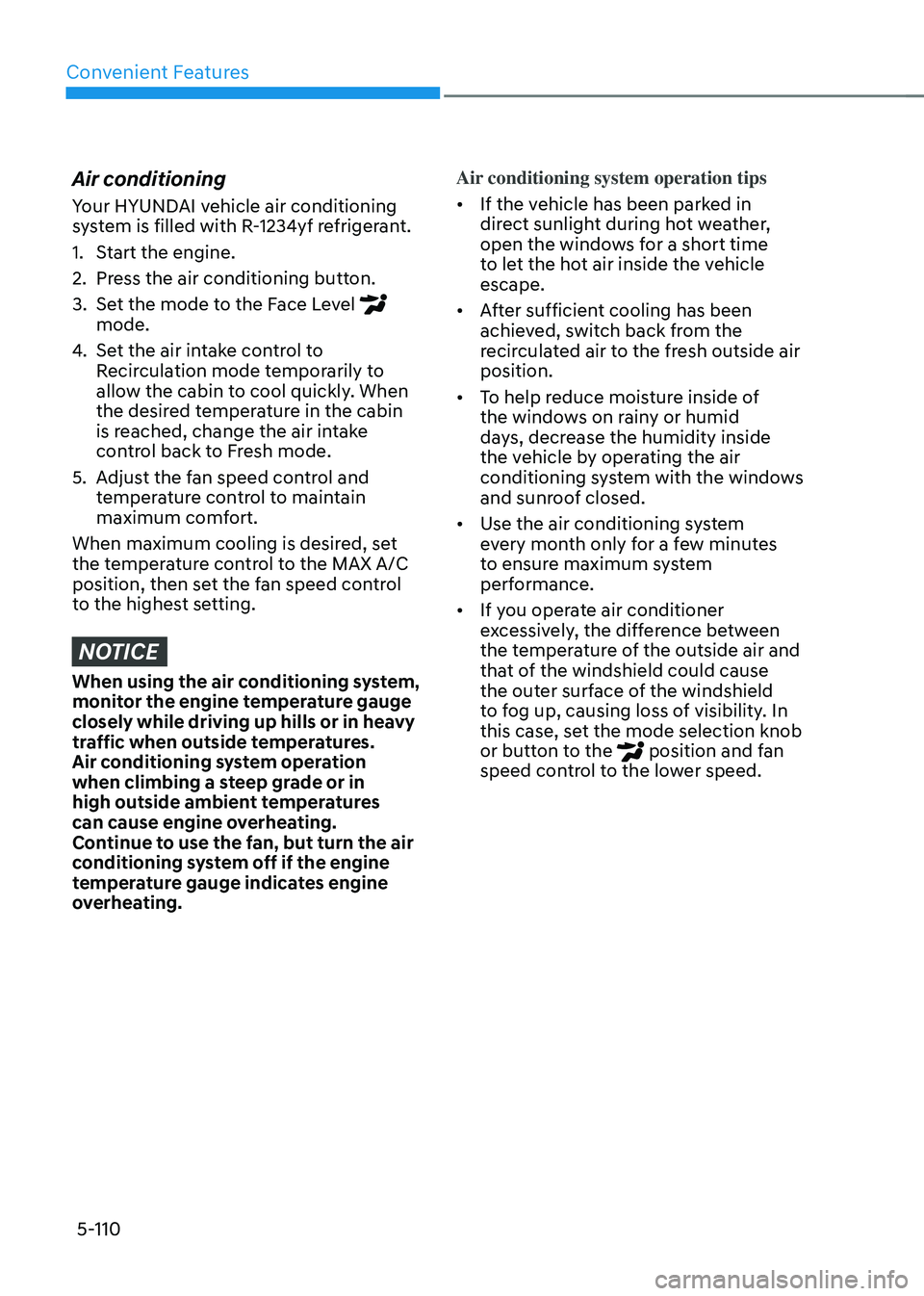
Convenient Features
5-110
Air conditioning
Your HYUNDAI vehicle air conditioning
system is filled with R-1234yf refrigerant.
1. Start the engine.
2. Press the air conditioning button.
3. Set the mode to the Face Level mode.
4. Set the air intake control to
Recirculation mode temporarily to
allow the cabin to cool quickly. When
the desired temperature in the cabin
is reached, change the air intake
control back to Fresh mode.
5. Adjust the fan speed control and
temperature control to maintain
maximum comfort.
When maximum cooling is desired, set
the temperature control to the MAX A/C
position, then set the fan speed control
to the highest setting.
NOTICE
When using the air conditioning system,
monitor the engine temperature gauge
closely while driving up hills or in heavy
traffic when outside temperatures.
Air conditioning system operation
when climbing a steep grade or in
high outside ambient temperatures
can cause engine overheating.
Continue to use the fan, but turn the air
conditioning system off if the engine
temperature gauge indicates engine
overheating. Air conditioning system operation tips
•
If the vehicle has been parked in
direct sunlight during hot weather,
open the windows for a short time
to let the hot air inside the vehicle
escape.
• After sufficient cooling has been
achieved, switch back from the
recirculated air to the fresh outside air
position.
• To help reduce moisture inside of
the windows on rainy or humid
days, decrease the humidity inside
the vehicle by operating the air
conditioning system with the windows
and sunroof closed.
• Use the air conditioning system
every month only for a few minutes
to ensure maximum system
performance.
• If you operate air conditioner
excessively, the difference between
the temperature of the outside air and
that of the windshield could cause
the outer surface of the windshield
to fog up, causing loss of visibility. In
this case, set the mode selection knob
or button to the
position and fan speed control to the lower speed.
Page 261 of 527
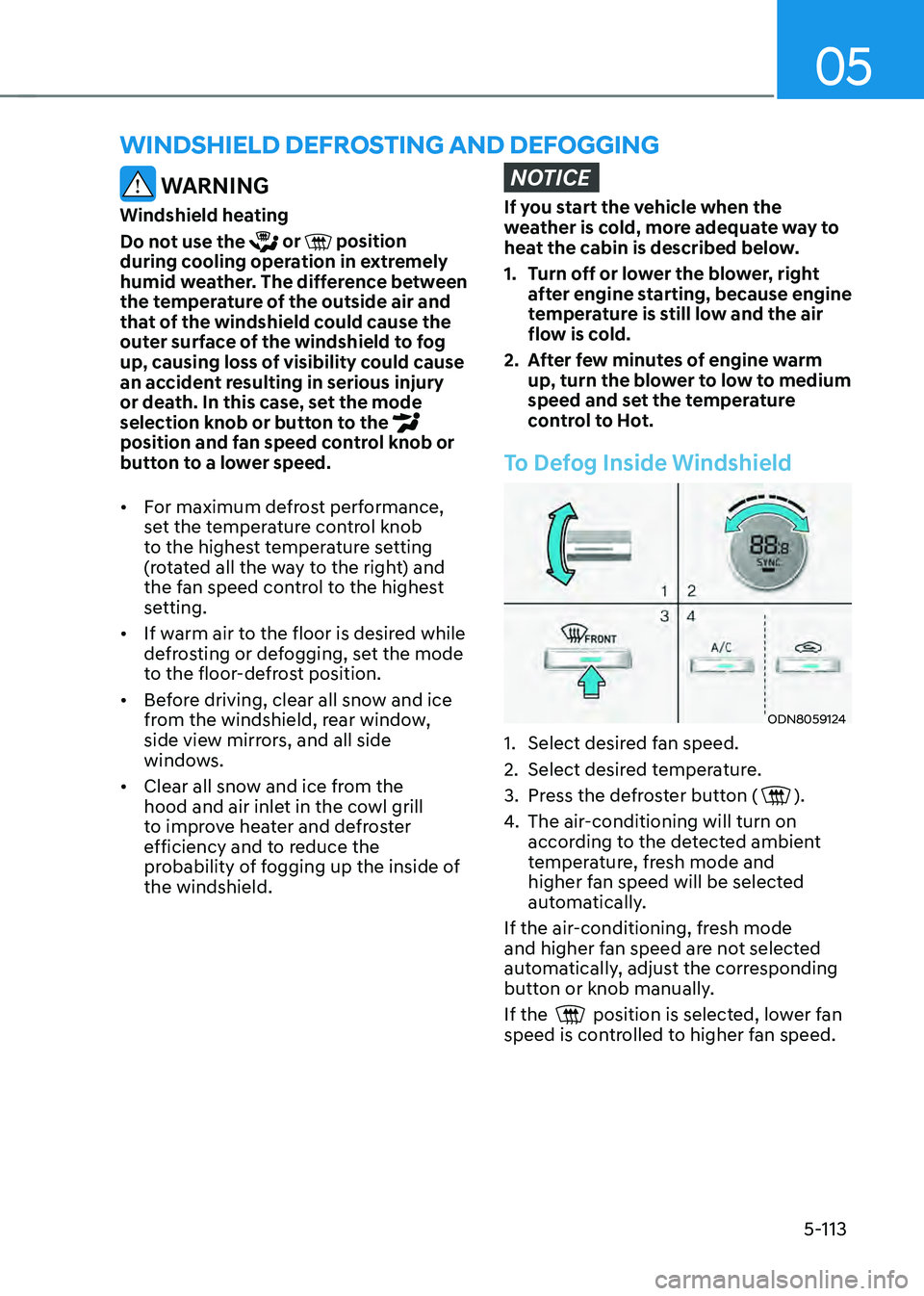
05
5-113
WINDSHIELD DEFROSTING AND DEFOGGING
WARNING
Windshield heating
Do not use the
or position during cooling operation in extremely
humid weather. The difference between
the temperature of the outside air and
that of the windshield could cause the
outer surface of the windshield to fog
up, causing loss of visibility could cause
an accident resulting in serious injury
or death. In this case, set the mode
selection knob or button to the
position and fan speed control knob or
button to a lower speed.
• For maximum defrost performance,
set the temperature control knob
to the highest temperature setting
(rotated all the way to the right) and
the fan speed control to the highest
setting.
• If warm air to the floor is desired while
defrosting or defogging, set the mode
to the floor-defrost position.
• Before driving, clear all snow and ice
from the windshield, rear window,
side view mirrors, and all side
windows.
• Clear all snow and ice from the
hood and air inlet in the cowl grill
to improve heater and defroster
efficiency and to reduce the
probability of fogging up the inside of
the windshield.
NOTICE
If you start the vehicle when the
weather is cold, more adequate way to
heat the cabin is described below.
1. Turn off or lower the blower, right
after engine starting, because engine
temperature is still low and the air
flow is cold.
2. After few minutes of engine warm
up, turn the blower to low to medium
speed and set the temperature
control to Hot.
To Defog Inside Windshield
ODN8059124
1. Select desired fan speed.
2. Select desired temperature.
3. Press the defroster button ().
4. The air-conditioning will turn on
according to the detected ambient
temperature, fresh mode and
higher fan speed will be selected
automatically.
If the air-conditioning, fresh mode
and higher fan speed are not selected
automatically, adjust the corresponding
button or knob manually.
If the
position is selected, lower fan speed is controlled to higher fan speed.
Page 413 of 527
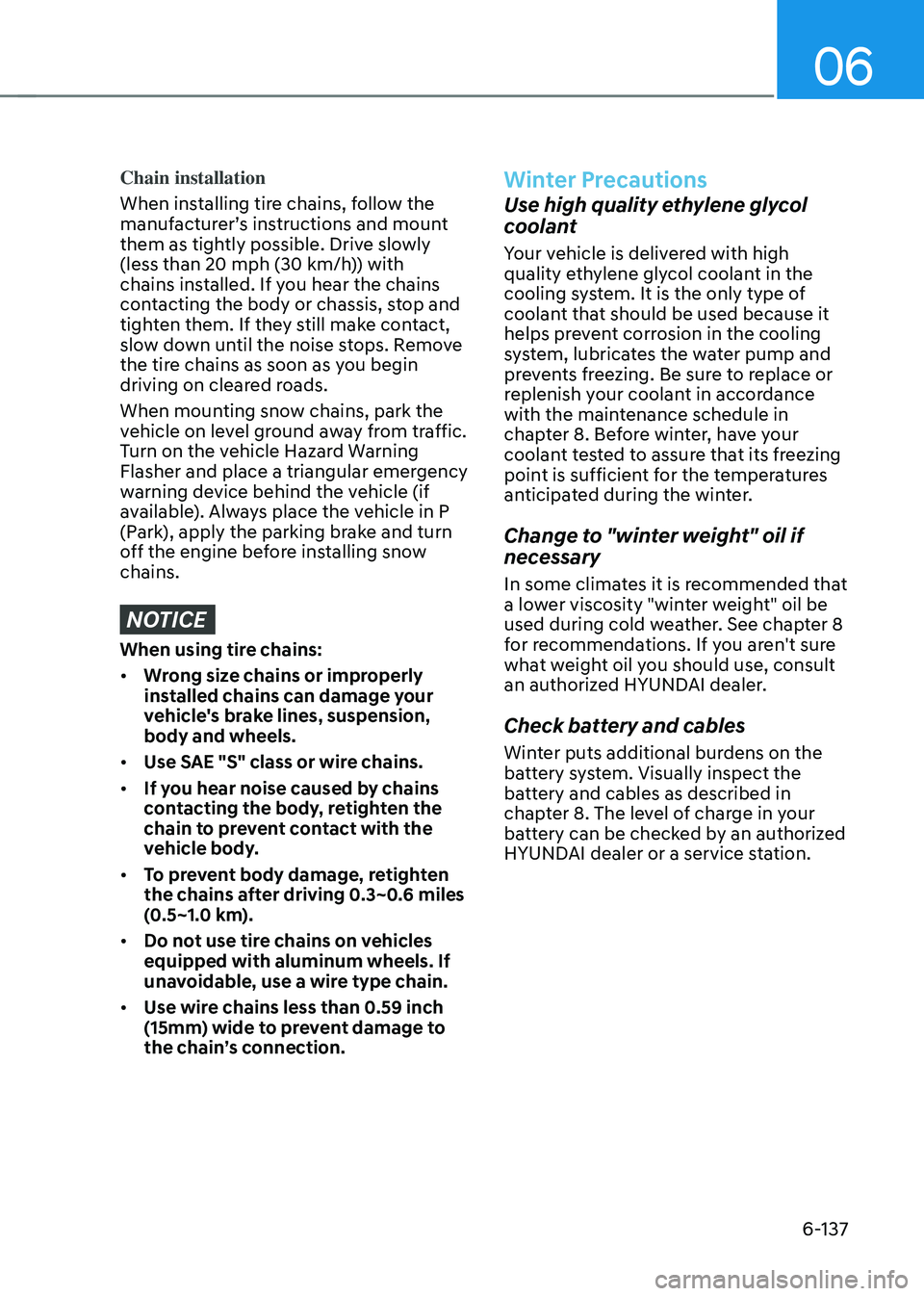
06
6-137
Chain installation
When installing tire chains, follow the
manufacturer’s instructions and mount
them as tightly possible. Drive slowly
(less than 20 mph (30 km/h)) with
chains installed. If you hear the chains
contacting the body or chassis, stop and
tighten them. If they still make contact,
slow down until the noise stops. Remove
the tire chains as soon as you begin
driving on cleared roads.
When mounting snow chains, park the
vehicle on level ground away from traffic.
Turn on the vehicle Hazard Warning
Flasher and place a triangular emergency
warning device behind the vehicle (if
available). Always place the vehicle in P
(Park), apply the parking brake and turn
off the engine before installing snow
chains.
NOTICE
When using tire chains:
• Wrong size chains or improperly
installed chains can damage your
vehicle's brake lines, suspension,
body and wheels.
• Use SAE "S" class or wire chains.
• If you hear noise caused by chains
contacting the body, retighten the
chain to prevent contact with the
vehicle body.
• To prevent body damage, retighten
the chains after driving 0.3~0.6 miles
(0.5~1.0 km).
• Do not use tire chains on vehicles
equipped with aluminum wheels. If
unavoidable, use a wire type chain.
• Use wire chains less than 0.59 inch
(15mm) wide to prevent damage to
the chain’s connection.
Winter Precautions
Use high quality ethylene glycol
coolant
Your vehicle is delivered with high
quality ethylene glycol coolant in the
cooling system. It is the only type of
coolant that should be used because it
helps prevent corrosion in the cooling
system, lubricates the water pump and
prevents freezing. Be sure to replace or
replenish your coolant in accordance
with the maintenance schedule in
chapter 8. Before winter, have your
coolant tested to assure that its freezing
point is sufficient for the temperatures
anticipated during the winter.
Change to "winter weight" oil if
necessary
In some climates it is recommended that
a lower viscosity "winter weight" oil be
used during cold weather. See chapter 8
for recommendations. If you aren't sure
what weight oil you should use, consult
an authorized HYUNDAI dealer.
Check battery and cables
Winter puts additional burdens on the
battery system. Visually inspect the
battery and cables as described in
chapter 8. The level of charge in your
battery can be checked by an authorized
HYUNDAI dealer or a service station.